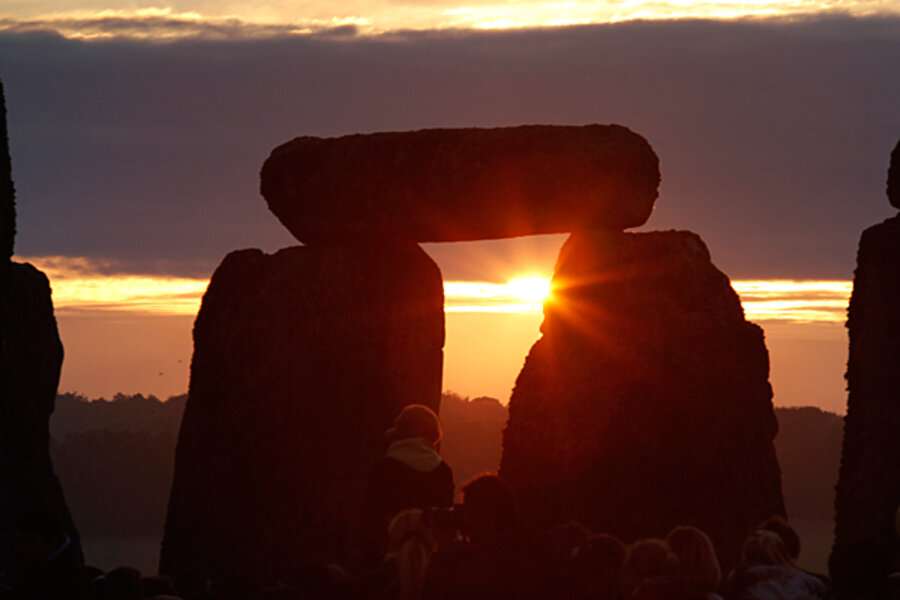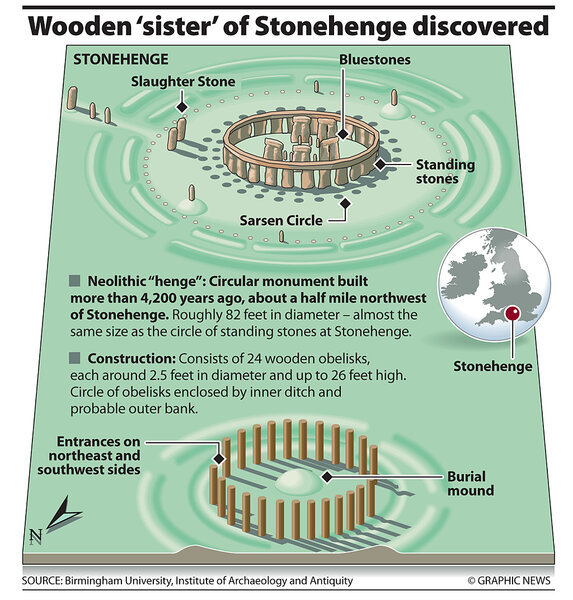Stonehenge twin – 'Timberhenge' – discovered with radar imaging
Loading...
Stonehenge, the mysterious circle of mammoth stone pillars in the middle of the English countryside, now has a slightly smaller twin.
Scientist have discovered a second henge formation that once existed nearby made from huge timbers.
And there could be many more henge-type circles yet to be found in the vicinity, says archeologist Vince Gaffney of the University of Birmingham, which is leading an expedition of the site along with the Ludwig Boltzmann Institute of Austria.
IN PICTURES: Summer Solstice at Stonehenge
"We didn’t expect to find another henge. There’s always been some presumption that the stones existed in splendid isolation," Professor Gaffney says.
On July 16, just two weeks into their four-year project, Gaffney's team discovered ‘Timberhenge,’ a 25-meter (82-foot) diameter, circular series of holes that were once filled with 24 huge wooden poles. It sits about 900 meters away from Stonehenge in southern England.
“Stonehenge isn’t the only henge monument in the area. There are several in the immediate vicinity,” says Dr. Gaffney, reached by phone today from Stonehenge.
‘Henge’ refers to a circular ditch with an external bank from the Neolithic period.
Archaeology without a shovel
Notably, not a bit of earth was dug up to make the discovery.
Gaffney’s ground-mapping project uses radar-imaging equipment, which is placed a wheels and pulled over the fields surrounding Stonehenge. His team plans to scan a 14-square-kilometer (nearly 9 mile) area at a cost of $500,000 to $1 million.
“We will not dig anything. The technologies we use will allow us to look at volumes of soil,” he says.
The new Timberhenge appears built on the same orientation as Stonehenge, with entrances to the northeast and southwest. Archaeologists say it was a worshipping site and burial ground, but Gaffney says the precise role of the structures remains unclear: Was it for commoners or tribal leaders, worshippers or religious leaders?
The radar-imaging project will provide a map of the area's structures and a clearer idea of its size and functions.
Scientists have repeatedly unearthed new finds at Stonehenge.
In October 2009, the Stonehenge Riverside Project uncovered a 10-meter (33-foot) diameter stone circle of bluestones, brought from the Preseli mountains of Wales, 150 miles away, and dubbed 'Bluestonehenge.' The stones, now missing, once marked the end of an avenue that leads from the River Avon to Stonehenge, a nearly 2-mile-long processional route constructed at the end of the Stone Age.
Another Woodhenge
Nor is this the first wooden henge found in the area. Two miles northeast of Stonehenge sits the so-called ‘Woodhenge,’ a six-ringed circle of 168 timber holes identified in 1925. Another timber circle nearby was identified in 1966.
But Mike Parker Pearson of the University of Sheffield, director of The Stonehenge Riverside Project, says it's premature to describe this latest find as another "Woodhenge."
"No one has any idea if these were circles of posts, stones or just pits. Nor do we know what date they are other than broadly 3000-1500 BC. They are both great finds but we know too little about them as yet (without excavation) to say how they will change our understanding," he says via email. "As we found last year with Bluestonehenge, there is still much to be found around Stonehenge."
Gaffney agrees that much remains unknown.
“Despite the fact that this is probably the most studied landscapes in the world…we know nothing about it,” says Gaffney. “Having said that, we felt we needed to know much more about what was happening between the monuments to know how it’s organized.”
On Thursday, however, southern England’s summer rains had delayed further scans of the area, and sent Gaffney running for shelter in a car.
“It’s raining heavily, so we’re not doing anything at the moment,” he told the Monitor. "It’s a British summer: what do you expect?"
IN PICTURES: Summer Solstice at Stonehenge
Related:






